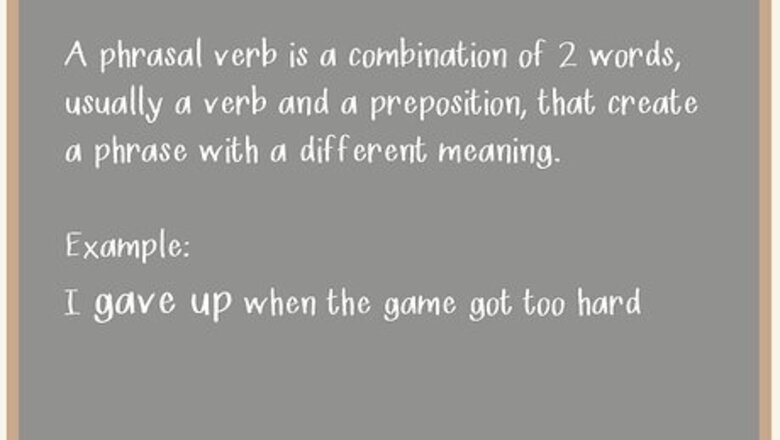
views
Introducing and Defining Phrasal Verbs
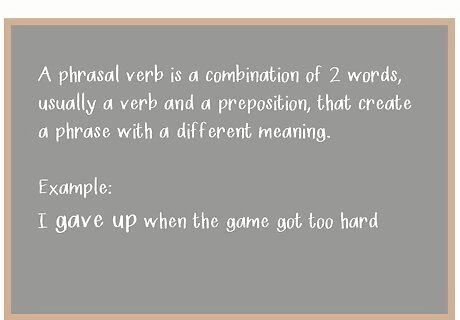
Teach the construction of a phrasal verb. Start with the basic definition and construction of phrasal verbs so your students can get a baseline. A phrasal verb is a combination of 2 words, usually a verb and a preposition, that create a phrase with a different meaning. The entire phrase acts as the verb in the sentence. Remember that a verb is an action word like "ran" or "look." A preposition is a word that establishes a relationship between two parts of a sentence. For instance, in “She arrived after dinner,” the preposition is “after.” Review this concept with your students if you haven’t already. Most often, a phrasal verb is a combination of a verb and a preposition. For example, in the sentence "I gave up when the game got too hard," the phrasal verb is "gave up." Teach your students to recognize these combinations.
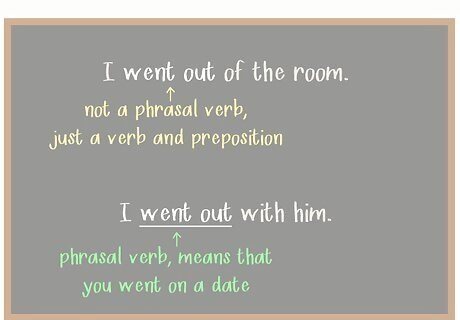
Identify when a verb and preposition combination is not a phrasal verb. Not all verb and preposition combinations are phrasal verbs. For a phrase to be a phrasal verb, it must have an entirely new meaning from the 2 words separately. Have your students test word combinations to see if they are phrasal verbs. If the phrase has a different meaning than the 2 words individually, then it is a phrasal verb. For example, in “I went out of the room,” “went out” is just a verb and preposition that literally means that you exited the room. However, in “I went out with him,” “went out” means that you went on a date. This is a phrasal verb because “went out” doesn’t literally mean you exited a place.
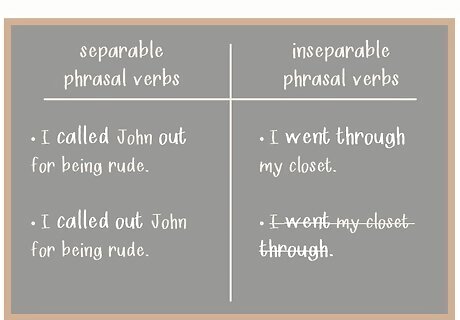
Explain the difference between separable and inseparable phrasal verbs. Some phrasal verbs can have a direct object in between their verb and prepositions. This means they are separable. Inseparable phrasal verbs must stay together or they won’t make sense. The only way to tell if on is separable or inseparable is by trying the sentence both ways and seeing if they both make sense. For example, “I called John out for being rude” and “I called out John for being rude” both work grammatically. This means that the phrasal verb “called out” is separable. However, “I went through my closet” works, while “I went my closet through” does not. This means that the phrasal verb “went through” is inseparable, because sentences don’t make sense with the phrase broken up.

Introduce a small list of phrasal verbs every day. Don’t overwhelm your students with long lists of words that they have to memorize. When you start teaching phrasal verbs, introduce them slowly. Try starting each class with a list of 5-10 phrasal verbs and reviewing their meanings. This way, the students gradually build up a list of phrasal verbs without getting overwhelmed. Always explain why these phrases are phrasal verbs as well. If you teach them how phrasal verbs are used and constructed, then they can recognize them later on.
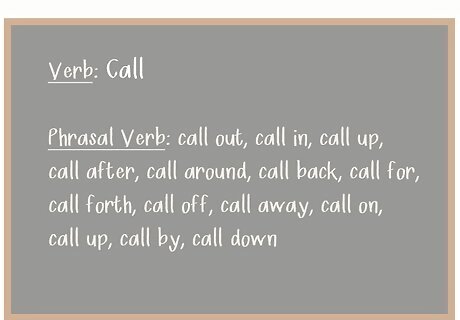
Organize phrasal verbs into categories. Since there are so many phrasal verbs, grouping similar ones together can helps students learn better. People learn better with patterns than with random selections. Picking out groups of phrasal verbs that begin with the same word, for example, is a good way to organize the phrases. Build a list of phrasal verbs that start with the same word. “Call” is one choice. Then take students through the different meanings of “call out,” “call in,” “call up,” and all the other possible combinations.
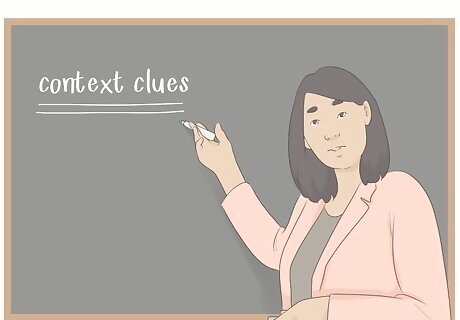
Teach students how to figure out verbs using context clues. There are over 2,000 phrasal verbs in English, so it’s not possible for them to memorize each one. Rather than having students memorize lists of words, teach them how to identify phrasal verbs from sentence context clues. Show them a sentence and circle the phrasal verb. Ask them to give you a definition of the verb based on its use in the sentence. Help the students along by asking questions, but let them figure out the definition. This helps them learn better. Remember that the main sign that something is a phrasal verb is when the phrase has a different meaning than the 2 words by themselves. Have students break down verb and preposition combinations to see if each word works by itself, or if it has to be a single phrase to make sense. "Wear out," for example, means to make something old or unusable. This is a much different meaning than "wear" and "out" by themselves. However, in "Go up the stairs," the verb "go" and the preposition "up" work individually, and don't need to be a phrase to make sense. Drill your students on recognizing these distinctions. Try having students then use that phrasal verb in a different sentence. This further trains them in proper usage for the verbs.

Have your students to look up phrasal verbs in the dictionary. If students are confused or lost and can’t figure out if a word is a phrasal verb, they can look it up in the dictionary. Phrasal verbs come after the singular verb in the dictionary. Let them use dictionaries when they’re first learning phrasal verbs to help them if they get stuck. If a student isn’t sure if “give up” is a phrasal verb, they can look it up in the dictionary. It appears after “give” and is officially labeled as a phrasal verb. Students can use paper or online dictionaries. Online dictionaries may be more up to date than paper dictionaries, unless they’re new.
Assessing Student Progress
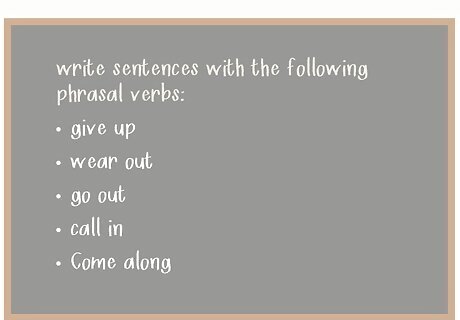
Have your students write sentences with a phrasal verb you give them. Once you’ve introduced students to phrasal verbs, design activities where the class uses the verbs in their own sentences. Write a phrasal verb on the board. Then give the students time to write 1 or more sentences using that phrasal verb properly. For a participatory activity, have students read their sentences aloud to the class. Ask the class to decide if students have used the verbs correctly or not. You can also make this an individual assignment that students will hand in. You can then grade everyone’s sentences to see if your point is getting across.
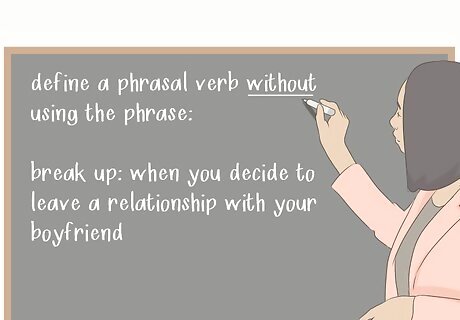
Ask students to define a phrasal verb without using the phrase. For another class activity, tell one student a phrasal verb. Then have them go to the front of the room and define that phrase without using the two words. Let the class guess which phrasal verb they are describing. If you assign a student “break up” for their phrasal verb, they could say “when you decide to leave a relationship with your boyfriend.” This should tip the class off that the student is describing a break-up.
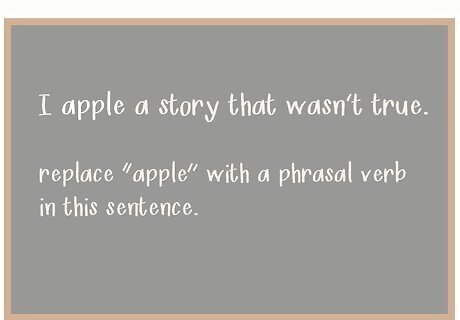
Replace the phrasal verb in a sentence with another word as a quiz. This activity may sound strange at first, but it trains students to use context clues to figure out phrasal verbs. Write a sentence on the board or say it out loud, but replace the phrasal verb with a random noun, like “apple.” If you’ve constructed a sentence with enough context clues, the students should be able to tell what the phrasal verb was. For example, if you say “I apple a story that wasn’t true,” the context clues should tell the students that the phrasal verb in this sentence is “made up.” Do this for several sentences to make your point. Once students get good at this, ask for volunteers to do the same. The class will have fun with this activity.
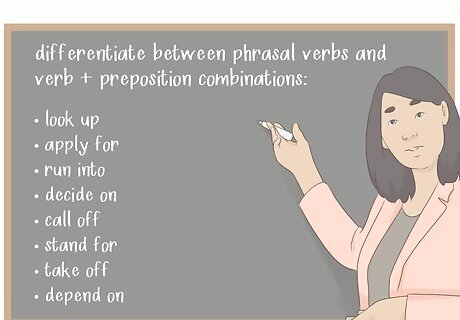
Make students differentiate between phrasal verbs and verb + preposition combinations. Once the students get proficient at picking out phrasal verbs for themselves, advance the activities to differentiating between phrasal verbs and plain verb + preposition combinations. Once they can accurately choose between the two for themselves, then they are very well-versed in what phrasal verbs are. Remind the students that for something to be a phrasal verb, the phrase must mean something different from the two words individually. As an activity, give the students a worksheet of some sentences that use phrasal verbs and some that use plain verb + preposition combinations. They have to use clues from the sentence to figure out which is which.
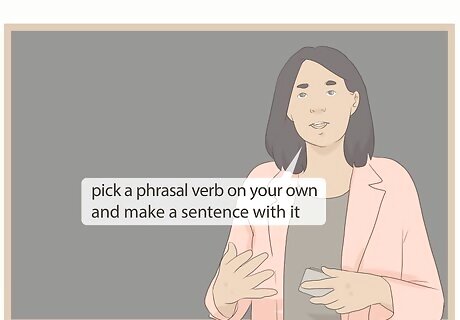
Test students on picking out phrasal verbs themselves. Once you’ve done guided activities explaining and identifying phrasal verbs, let the students choose them for themselves. Use handouts, worksheets, or other activities where the students have to identify the phrasal verbs in sentences. Do a few guided group activities first so students get used to identifying phrasal verbs. Then move on to individual activities. Consider making this activity ungraded at first so the students can learn without getting discouraged. Then give a graded quiz or test when you’ve taught the subject completely. The early lessons for ESL students should include pronouns and basic vocabulary. For example, family members, animals, numbers, and basic actions. They should know to build a basic sentence. And be familiar with present simple, past simple, and future simple tense.


















Comments
0 comment